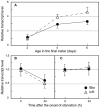A switch in the control of growth of the wing imaginal disks of Manduca sexta
- PMID: 20502707
- PMCID: PMC2873286
- DOI: 10.1371/journal.pone.0010723
A switch in the control of growth of the wing imaginal disks of Manduca sexta
Abstract
Background: Insulin and ecdysone are the key extrinsic regulators of growth for the wing imaginal disks of insects. In vitro tissue culture studies have shown that these two growth regulators act synergistically: either factor alone stimulates only limited growth, but together they stimulate disks to grow at a rate identical to that observed in situ. It is generally thought that insulin signaling links growth to nutrition, and that starvation stops growth because it inhibits insulin secretion. At the end of larval life feeding stops but the disks continue to grow, so at that time disk growth has become uncoupled from nutrition. We sought to determine at exactly what point in development this uncoupling occurs.
Methodology: Growth and cell proliferation in the wing imaginal disks and hemolymph carbohydrate concentrations were measured at various stages in the last larval instar under experimental conditions of starvation, ligation, rescue, and hormone treatment.
Principal findings: Here we show that in the last larval instar of M. sexta, the uncoupling of nutrition and growth occurs as the larva passes the critical weight. Before this time, starvation causes a decline in hemolymph glucose and trehalose and a cessation of wing imaginal disks growth, which can be rescued by injections of trehalose. After the critical weight the trehalose response to starvation disappears, and the expression of insulin becomes decoupled from nutrition. After the critical weight the wing disks loose their sensitivity to repression by juvenile hormone, and factors from the abdomen, but not the brain, are required to drive continued growth.
Conclusions: During the last larval instar imaginal disk growth becomes decoupled from somatic growth at the time that the endocrine events of metamorphosis are initiated. These regulatory changes ensure that disk growth continues uninterrupted when the nutritive and endocrine signals undergo the drastic changes associated with metamorphosis.
Conflict of interest statement
Figures










Similar articles
-
The control of growth and differentiation of the wing imaginal disks of Manduca sexta.Dev Biol. 2007 Feb 15;302(2):569-76. doi: 10.1016/j.ydbio.2006.10.023. Epub 2006 Oct 21. Dev Biol. 2007. PMID: 17112498
-
Bombyxin is a growth factor for wing imaginal disks in Lepidoptera.Proc Natl Acad Sci U S A. 2002 Nov 26;99(24):15446-50. doi: 10.1073/pnas.242548399. Epub 2002 Nov 12. Proc Natl Acad Sci U S A. 2002. PMID: 12429853 Free PMC article.
-
Insulin/IGF signaling regulates the change in commitment in imaginal discs and primordia by overriding the effect of juvenile hormone.Dev Biol. 2008 Dec 15;324(2):258-65. doi: 10.1016/j.ydbio.2008.09.017. Epub 2008 Sep 25. Dev Biol. 2008. PMID: 18845136
-
The morphostatic actions of juvenile hormone.Insect Biochem Mol Biol. 2007 Aug;37(8):761-70. doi: 10.1016/j.ibmb.2007.05.011. Epub 2007 May 29. Insect Biochem Mol Biol. 2007. PMID: 17628276 Review.
-
Regulation and consequences of cellular changes in the prothoracic glands of Manduca sexta during the last larval instar: a review.Arch Insect Biochem Physiol. 1995;30(2-3):271-93. doi: 10.1002/arch.940300214. Arch Insect Biochem Physiol. 1995. PMID: 7579575 Review.
Cited by
-
Big or fast: two strategies in the developmental control of body size.BMC Biol. 2015 Aug 4;13:57. doi: 10.1186/s12915-015-0173-x. BMC Biol. 2015. PMID: 26239356 Free PMC article.
-
Characterization of Rab-interacting lysosomal protein in the brain of Bombyx mori.Histochem Cell Biol. 2014 Mar;141(3):311-20. doi: 10.1007/s00418-013-1160-3. Epub 2013 Nov 5. Histochem Cell Biol. 2014. PMID: 24190830
-
Rab proteins in the brain and corpus allatum of Bombyx mori.Histochem Cell Biol. 2016 Jul;146(1):59-69. doi: 10.1007/s00418-016-1422-y. Epub 2016 Mar 15. Histochem Cell Biol. 2016. PMID: 26976000
-
Can multitrophic interactions shape morphometry, allometry, and fluctuating asymmetry of seed-feeding insects?PLoS One. 2020 Nov 11;15(11):e0241913. doi: 10.1371/journal.pone.0241913. eCollection 2020. PLoS One. 2020. PMID: 33175854 Free PMC article.
-
Diabetic silkworms for evaluation of therapeutically effective drugs against type II diabetes.Sci Rep. 2015 May 29;5:10722. doi: 10.1038/srep10722. Sci Rep. 2015. PMID: 26024298 Free PMC article.
References
-
- Kato Y, Riddiford LM. The role of 20-hydroxyecdysone in stimulating epidermal mitoses during the laval-pupal transformation of the tobacco hornworm, Manduca sexta. Development. 1987;100:227–236.
-
- Nijhout HF, Smith WA, Schachar I, Subramanian S, Tobler A, et al. The control of growth and differentiation of the wing imaginal disks of Manduca sexta. Developmental Biology. 2007;302:569–576. - PubMed
-
- Britton JS, Lockwood WK, Li L, Cohen SM, Edgar BA. Drosophila's insulin/P13-kinase pathway coordinates cellular metabolism with nutritional conditions. Developmental Cell. 2002;2:239–249. - PubMed
-
- Ikeya T, Galic M, Belawat P, Nairz K, Hafen E. Nutrient-dependent expression of insulin-like peptides from neuroendocrine cells in the CNS contributes to growth regulation in Drosophila. Current Biology. 2002;12:1293–1300. - PubMed
Publication types
MeSH terms
Substances
LinkOut - more resources
Full Text Sources

